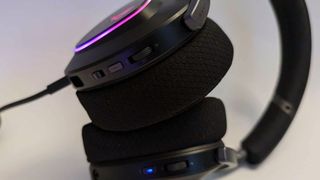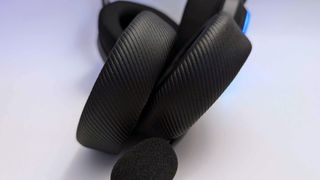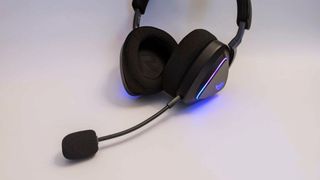Asus
ROG
Delta
II:
two-minute
review

(Image
credit:
Future
/
Mark
LoProto)
The
ROG
Delta
II
wireless
headset
is
the
latest
in
the
Asus
Republic
of
Gamers
line
of
audio
peripherals
for
gaming.
The
set
maximizes
comfort
without
diminishing
audio
quality
in
a
lightweight,
over-ear
headset
that’s
clearly
made
for
all
aspects
of
gaming.
While
gaming
peripherals
from
companies
like
ROG
or
Razer
can
feel
gimmicky
for
streamers
or,
at
the
very
least,
don’t
stand
up
to
higher-end,
general-purpose
counterparts,
the
Delta
II
is
surprisingly
versatile
and
even
excels
beyond
something
like
the
costlier
Audeze
Maxwell.
With
so
many
different
headsets
on
the
market,
ROG
had
to
find
a
way
to
separate
the
Delta
II
from
the
crowd,
and
despite
its
general
simplicity,
it
succeeded
in
most
ways.
The
biggest
surprise
is
the
comfort
level.
The
lightweight
design,
forgiving
band,
and
plush
mesh
or
PU
leather
ear
cushions
minimize
the
occurrence
of
headaches.
Even
with
a
looser
band,
the
earcup
creates
a
seal
that
cuts
down
on
external
noise
despite
no
active
noise
cancelation.

(Image
credit:
Future
/
Mark
LoProto)
While
on
the
higher
end
of
the
price
spectrum
when
compared
to
other
Delta
models,
the
Delta
II’s
$229
/
£219
/
AUS$368
price
tag
stings
less
when
you
start
noticing
audio
cues
that
may
have
been
otherwise
drowned
out
through
TV
speakers
or
a
lower
quality
headset.
The
plug-and-play
compatibility
with
the
PS5
(via
USB-C
dongle)
and
Xbox
Series
X/S
(via
3.5mm
cord)
are
vitally
convenient
and
provide
the
best
gaming
experience,
whereas
use
via
PC
(Bluetooth
or
USB-C)
can
be
tweaked
and
customized
using
the
Armoury
Crate
software.
Asus
ROG
Delta
II:
Price
and
availability
-
When
is
it
available?
Available
now -
How
much
does
it
cost?
$229
/
£219
/
AUS$368 -
Where
can
you
get
it?
Available
in
the
US,
UK,
and
AUS
The
ROG
Delta
II
officially
launched
on
September
12,
2024,
at
a
price
point
of
$229
/
£219
/
AUS$368.
Though
fairly
high,
especially
for
a
gaming
headset,
the
Delta
II
justifies
the
cost
with
a
build
that
makes
the
Delta
S
and
its
50mm
Asus
essence
drivers
obsolete.
Titanium
is
where
it’s
at
for
a
fuller
audio
experience
that
elevates
game
audio
design
to
ensure
even
the
most
subtle
cues
aren’t
missed.
There’s
a
market
for
the
ROG
Delta
II;
it
just
may
not
be
the
casual
player
who
picks
up
a
controller
every
few
weeks.
Someone
willing
to
drop
$229
on
a
wireless
headset
when
there
are
options
for
more
than
half
the
price
will
better
appreciate
the
enhanced
audio
provided
by
the
50mm
titanium
drivers.
Though
the
headset
does
work
quite
nicely
for
PC,
it
almost
feels
like
a
console-specific
accessory,
especially
since
connecting
any
headset
to
an
Xbox
or
PS5
isn’t
as
simple
as
establishing
a
Bluetooth
connection,
and
compatibility
isn’t
guaranteed.
What
really
justifies
the
price
is
how
well
the
headset
handles
the
PS5’s
spatial
audio
to
suck
players
in.
With
that
being
said,
that’s
only
good
for
PS5
players,
leaving
Xbox
gamers
to
once
again
deal
with
the
antiquated
3.5mm
audio
plug.
That’s
when
it
gets
difficult
to
recommend
a
$200-plus
headset
because
while
the
drivers
work
wonders,
I
can’t
help
but
wonder
if
the
much
cheaper,
3.5mm-compatible
Delta
Core
could
get
the
job
done
for
very
casual
players.
-
Value:
3.5
/
5
Asus
ROG
Delta
II:
Specs
to
scroll
horizontally
| Type: |
Wireless over-ear |
| Drivers: |
50mm Titanium-plated diaphragm |
| Weight: |
11.2oz (318g) |
| Connectivity: |
Bluetooth, 2.4Ghz with ROG SpeedNova, 3.5mm |
| Sensitivity: | -40dB |
| Impedance: | 32ohm |
|
Frequency range: |
20Hz – 20KHz |
|
Frequency response: |
100Hz – 10KHz |
Asus
ROG
Delta
II:
Features
-
DualFlow
Audio
for
simultaneous
device
use -
Tri-Mode
connectivity
with
ROG
SpeedNova -
Few
features
lend
to
a
user-friendly
experience
ROG
didn’t
go
too
heavy
on
features
for
the
Delta
II,
which
is
a
double-edged
sword.
On
one
hand,
it
allows
the
headset’s
base
audio
quality
to
shine
without
forcing
you
to
navigate
a
sea
of
button
presses
and
app
integrations.
The
Delta
II
caters
to
a
plug-and-play
crowd,
especially
for
consoles.
It
also
supports
the
notion
that
this
headset
isn’t
meant
for
audiophiles,
and
even
casual
players
can
get
the
most
out
of
the
titanium
drivers
without
fuss.
Then
again,
an
older
competitor
like
Razer’s
Kaira
Pro
(2022),
which
retails
for
only
$30
less
(for
the
PS5
model),
is
brimming
with
different
audio-enhancing
features.
Along
with
haptic
feedback,
the
Kaira
Pro
includes
a
toggle
that
swaps
between
improved
bass,
amplified
audio,
and
a
gaming
profile
for
a
more
diverse
user
experience.
You
may
be
wondering
why
you’d
spend
more
for
what
seems
like
less,
but
the
Delta
II’s
success
is
that
it
hones
in
on
a
well-rounded
build
to
render
all
of
those
enhancements
unnecessary.
Of
course,
you
can
still
control
your
sound
design
on
a
PC.
The
Delta
II
connects
with
ROG’s
Armoury
Crate
software
to
optimize
sound
with
toggles
for
an
equalizer,
reverb,
and
virtual
surround
sound
along
with
slides
for
bass
boost
and
compression.
You
can
also
choose
between
preset
profiles
for
movies,
music,
gaming,
and
communicating,
which
change
the
necessary
settings
to
adjust
sound
for
each
application.
One
of
the
Delta
II’s
more
interesting
features
is
DualFlow
Audio.
Using
both
the
2.4
GHz
wireless
and
Bluetooth,
it
feeds
audio
from
two
devices
simultaneously.
That
may
sound
like
chaos,
but
it’s
a
great
way
to
game
on
a
PS5
and
still
be
able
to
use
Discord
(or
TeamSpeak,
if
you’re
still
using
it)
or
chat
with
viewers
on
the
PC
without
a
mixer
or
additional
equipment.
The
input
audio
skipped
infrequently,
but
the
rare
hiccup
is
worth
dealing
with
for
something
so
simple
and
useful.
None
of
this
matters
all
that
much
if
the
headset
is
dead
within
hours
of
charging.
Thankfully,
ROG
found
a
way
to
prolong
the
life
of
the
Delta
II
to
up
to
over
110
hours
(using
2.4GHz
wireless
without
RGB
lighting).
I
tried
to
run
the
battery
dry,
but
it’s
quite
resilient
and
looks
like
it
does
live
up
to
at
least
a
sizable
portion
of
that
110
hours.
ROG
also
boasts
a
quick
charge,
where
you
can
squeeze
11
hours
of
use
time
after
only
15
minutes
on
the
included
USB-C
charger.
-
Features:
4
/
5
Asus
ROG
Delta
II:
Sound
quality

(Image
credit:
Future
/
Mark
LoProto)
-
Full-bodied
audio
that
struggles
with
deeper
bass -
Binaural
audio
is
immersive
and
crystal
clear -
Detachable
microphone
could
use
some
work
After
running
a
simple
online
bass
test,
I
realized
there
were
a
few
hiccups
in
the
Delta
II’s
sound
quality.
While
that
should
be
a
negative
mark,
it
really
indicated
that
the
headset
was
specifically
designed
for
gaming,
especially
since
the
worst
offense
was
vibrating
drivers
at
a
low
frequency
I
wouldn’t
expect
to
hear
in
a
video
game.
Some
music
with
deeper
bass
may
cause
the
drivers
to
vibrate,
but
the
Delta
II
isn’t
really
made
for
music.
Sure,
you
can
connect
to
your
iPhone
and
blast
your
favorite
tunes,
but
ROG
cares
more
about
making
sure
you
feel
like
you’re
in
the
middle
of
Liberty
City.
Across
most
of
the
games
I
tested
the
Delta
II
with,
I
discovered
the
immersion
I
was
missing
by
using
TV
speakers.
My
favorite
experience
with
the
Delta
II
was
Returnal.
Having
heard
the
game
through
the
TV
and
the
Audeze
Maxwell,
I
was
not
prepared
for
how
different
it
would
sound
with
the
titanium
drivers.
It
engulfs
you
in
the
alien
world
in
a
way
video
games
should,
with
every
bit
of
audio,
big
or
small,
sounding
like
they
were
in
the
room
with
me.
Even
Marvel’s
Spider-Man
2
sounded
better,
to
the
point
where
I
could
hear
the
faint
flapping
of
Spidey’s
wings
while
gliding.
On
PC,
I
toyed
with
Armoury
Crate’s
settings
but
pretty
much
always
returned
it
to
the
preset
gaming
mode.
It
provided
the
fullest
audio
of
the
lot,
making
games
like
Dead
Space
2
infinitely
more
horrifying.

(Image
credit:
Future
/
Mark
LoProto)
Playing
on
PC
also
highlighted
Delta
II’s
weakest
feature:
its
microphone.
Though
clear
(and
made
clearer
with
Armoury
Crate’s
noise
reduction
setting)
it
had
a
tendency
to
stutter.
It
did
seem
to
run
fine
on
the
PS5,
though,
and
teammates
could
hear
me
clearly
each
round
of
Killer
Klowns
from
Outer
Space.
-
Sound
quality:
4.5
/
5
ASUS
ROG
Delta
II:
Design

(Image
credit:
Future
/
Mark
LoProto)
-
Interchangeable
plush
ear
cushions -
Flexible
but
durable
headband -
Flimsy
microphone
design
There’s
little
to
complain
about
with
the
Delta
II’s
design.
Both
ear
cushions
are
very
cozy
and
create
a
good
seal
to
minimize
external
noise
without
pressing
too
hard
against
my
head.
The
fabric
and
PU
leather
cushions
were
equally
as
soft,
though
I
did
sweat
slightly
with
the
latter.
Adding
to
the
overall
comfort
is
the
headband.
I’m
used
to
headsets
that
squeeze
and
feel
tight
around
my
head,
but
the
Delta
II’s
band
doesn’t
share
that
aggression.
It
does
feel
a
little
cheap,
with
very
minimal
padding
at
the
top
of
the
head,
but
it
was
comfortable
enough
to
wear
for
several
hours
at
a
time
without
discomfort.
ROG
kept
things
very
simple
with
its
button
layout.
The
left
earcup
features
controls
for
the
volume
and
2.4GHz
dongle.
Opposite
that
are
the
controls
for
Bluetooth
connectivity
and
volume.
Function
buttons
on
both
sides
can
control
music
based
on
how
many
times
they’re
pressed,
making
for
a
very
user-friendly
design.
-
Design:
4
/
5
Should
you
buy
the
Asus
ROG
Delta
II?
to
scroll
horizontally
| Attributes | Notes | Rating |
|---|---|---|
| Features |
DualFlow Audio, Tri-Mode Connectivity, feature light for user-friendly functionality |
4 / 5 |
|
Sound quality |
Full-bodied, struggles with very deep bass, immersive 3D audio, detachable mic |
4.5 / 5 |
| Design |
Comfortable ear cushions, simple button layout, lower-quality mic arm |
4 / 5 |
| Value |
High-quality audio for a price, best of the ROG wireless line |
3.5 / 5 |
|
Average Rating |
A comfortable, clear-sounding gaming headset with a considerable price tag and as few faults as extra features |
4 / 5 |
Buy
them
if…
Don’t
buy
them
if…
Also
Consider
to
scroll
horizontally
|
Header Cell – Column 0 |
Logitech Pro X 2 Lightspeed |
SteelSeries Arctis Nova 7 Wireless |
Turtle Beach Stealth Pro |
|---|---|---|---|
| Price |
$249 / €269 |
$159.99 / £174.99 / AU$399 |
$329.99 / £279.99 / AU$599.95 |
| Drivers |
50mm Graphene |
40mm Neodymium |
50mm Nanoclear neodymium |
|
Active noise cancelation | No | Yes | Yes |
|
Battery life |
50 hours |
38 hours |
24 hours |
| Weight |
12.16oz (345g) |
11.45oz (325g) |
14.88oz (421g) |
| Connectivity |
2.4GHz wireless, Bluetooth, and 3.5mm wired |
2.4GHz wireless, Bluetooth, 3.5mm |
2.4GHz wireless, Bluetooth |
|
Frequency range |
20Hz – 20KHz |
20Hz – 22KHz |
10Hz – 22KHz |
How
I
tested
the
Asus
ROG
Delta
II
-
Tested
for
two
weeks -
Used
for
games
on
PC,
PS5,
and
Xbox
Series
S -
Used
in
an
open-walled
home
office
with
varying
degrees
of
noise
I
put
ROG’s
lightweight
headset
through
a
rigorous
process.
More
so
than
visuals,
I
value
sound
design
in
video
games,
so
I
focused
on
games
with
fantastic
audio
across
the
primary
platforms.
This
included
Returnal
(PS5),
Dead
Space
2
(PC),
and
Alan
Wake
2
(Xbox
Series
S).
By
using
different
platforms,
I
could
test
audio
quality
across
the
USB-C
2.4GHz
dongle,
the
3.5mm
cable,
and
the
Bluetooth
connection.
Using
each
game’s
base
audio
settings,
I
swapped
between
the
Delta
II,
my
Audaze
Maxwell,
and
the
speakers
built
into
my
Samsung
TV
to
pinpoint
basic
audio
quality
and
how
well
individual
audio
cues
and
background
noise
came
through
across
each
device.
I
also
performed
an
audio/microphone
test
via
Phasmophobia
(PC),
Ghostbusters:
Spirits
Unleashed
(PC),
and
Killer
Klown’s
from
Outer
Space:
The
Game
(PS5)
to
test
the
clarity
of
the
microphone
and
how
well
the
headset
mixed
in-game
audio
and
other
players.
Finally,
I
ran
the
headset
through
a
bass
test
designed
to
gauge
the
quality
of
the
drivers.
-
First
tested
in
September
2024
